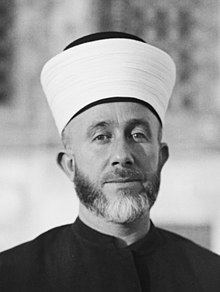Haj Amin al-Husseini
| Haj Amin al-Husseini | |
|---|---|
 |
|
| Amin al-Husseini (1929) | |
| Grand Mufti of Jerusalem | |
| In office 1921 – 1937[1][2][3][4] |
|
| Preceded by | Kamil al-Husayni |
| Succeeded by | Husam Al-din Jarallah |
| President of the Supreme Muslim Council | |
| In office 1922–1937 |
|
| Personal details | |
| Born | c. 1897 Jerusalem, Ottoman Empire |
| Died | 4 July 1974 Beirut, Lebanon |
| Political party | Arab Higher Committee |
| Profession | Mufti |
| Religion | Sunni Islam |
| Military service | |
| Allegiance |
|
Haj Mohammed Effendi Amin el-Husseini (Arabic: محمد أمين الحسيني;[5] c. 1897;[6][7] – 4 July 1974) was a Palestinian Arab nationalist and Muslim leader in Mandatory Palestine.[8]
Al-Husseini was the scion of a family of Jerusalemite notables.[9] After receiving an education in Islamic, Ottoman and Catholic schools, he went on to serve in the Ottoman army in World War I. At war’s end, he positioned himself in Damascus as a supporter of the Arab Kingdom of Syria. Following the fiasco of the Franco-Syrian War
and the collapse of the Arab Hashemite rule in Damascus, his early
position on pan-Arabism shifted to a form of local nationalism for
Palestinian Arabs and he moved back to Jerusalem. From as early as 1920,
in order to secure the independence of Palestine as an Arab state he
actively opposed Zionism, and was implicated as a leader of a violent riot that broke out over the establishment of a national home for the Jewish people in Palestine. Al-Husseini was sentenced to ten years imprisonment, but was pardoned by the British.[10] Starting in 1921, al-Husseini was appointed Grand Mufti of Jerusalem, using the position to promote Islam, while rallying a non-confessional Arab nationalism against Zionism.[11][12]
His opposition to the British peaked during the 1936–39 Arab revolt in Palestine. In 1937, evading an arrest warrant, he fled Palestine and took refuge in, successively, the French Mandate of Lebanon and the Kingdom of Iraq, until he established himself in Italy and Germany. During World War II he collaborated with both Nazi Germany and Fascist Italy by making propagandistic radio broadcasts and by helping Germans recruit Bosnian Muslims for the Waffen-SS. On meeting Adolf Hitler
he requested backing for Arab independence and support in opposing the
establishment in Palestine of a Jewish national home. At war’s end, he
came under French protection, and then sought refuge in Cairo to avoid
prosecution.
In the lead-up to the 1948 Palestine war, Husseini opposed both the 1947 UN Partition Plan and King Abdullah‘s designs to annex the Arab part of British Mandatory Palestine to Jordan, and, failing to gain command of the ‘Arab rescue army’ (jaysh al-inqadh al-‘arabi) formed under the aegis of the Arab League, formed his own militia, al-jihad al-muqaddas. In September 1948, he participated in establishment of All-Palestine Government.
Seated in Egyptian-ruled Gaza, this government won a limited
recognition of Arab states, but was eventually dissolved by Egyptian
president Gamal Abdel Nasser in 1959. After the war and subsequent Palestinian exodus, his claims to leadership, wholly discredited, left him eventually sidelined by the Palestine Liberation Organization, and he lost most of his residual political influence.[13] He died in Beirut, Lebanon, in July 1974. Husseini was and remains a highly controversial figure. Historians dispute whether his fierce opposition to Zionism was grounded in nationalism or antisemitism or a combination of both.
Contents